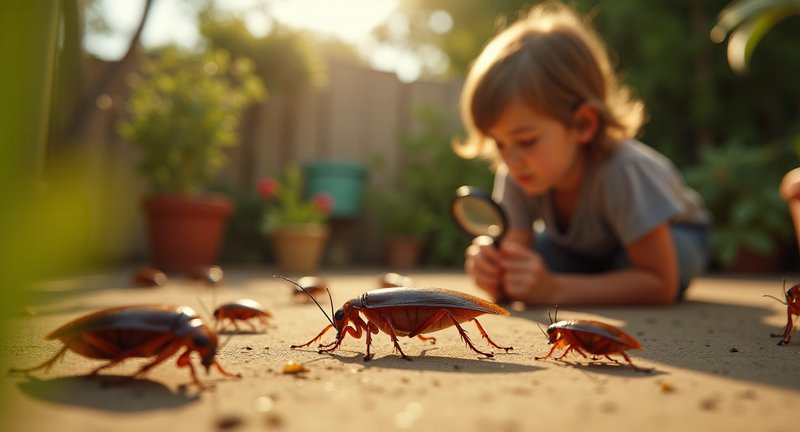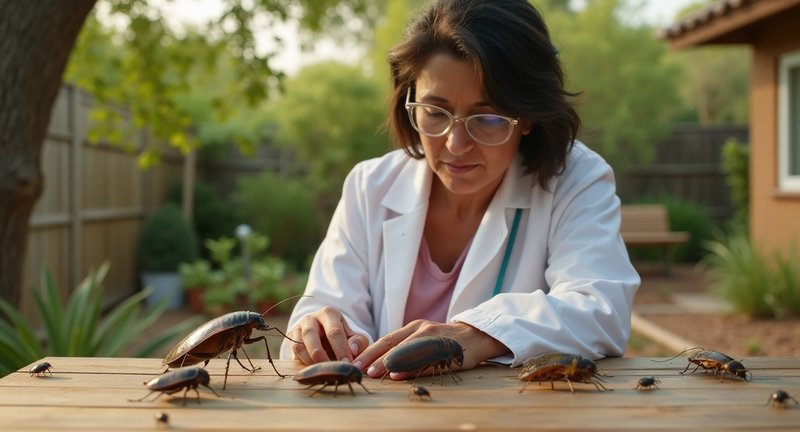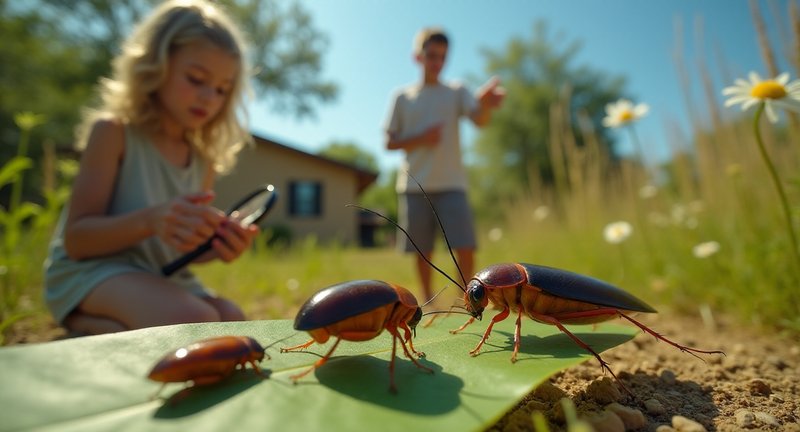Getting Started with Types of Cockroaches in Texas
Getting started with understanding the types of cockroaches in Texas can be an eye-opening experience (especially when one scurries across your kitchen floor). Yes, Texas is home to a variety of these little critters, and it’s important to get familiar with them, especially if you want to keep your home as roach-free as possible.

Here’s the deal: not all cockroaches are created equal. In Texas, we have a few major types that love to make an appearance, especially when the weather heats up. Here’s a quick rundown:
-
American Cockroach: This is the big one. If you’ve seen a massive cockroach and had a brief moment of terror, it was likely an American roach. They can grow up to 3 inches and often hang out in warm, damp areas like basements or under your sink.
-
German Cockroach: These little guys are smaller but cause a much bigger headache. German roaches are notorious for being tough to get rid of. They reproduce quickly and tend to hide in kitchens and bathrooms.
-
Smoky Brown Cockroach: Slightly smaller than the American cockroach, these roaches are typically found outdoors. They prefer warm, moist environments, like garden beds or piles of leaves, but they can sneak into homes, too.
-
Oriental Cockroach: Darker in color, these roaches are slow-moving and prefer cool, damp places like drains and sewers. While less common indoors, they can become a problem if they find their way into your basement or garage.
Each type has its own quirks and habits, so knowing which one you’re dealing with can help in controlling them. And trust me, living in Texas has taught me that roach control is an essential skill!
Understanding Types of Cockroaches in Texas
If you live in Texas, you’ve probably encountered these unwanted guests. Cockroaches here aren’t exactly the shy type; they’re experts in making themselves known in just about every corner of the state.
From urban to rural areas, they come in all shapes and sizes, each with its own sneaky habits. Some thrive in the damp and dark places, while others boldly saunter through your kitchen in broad daylight. The way they adapt to different environments is something that can make any homeowner pause.
The ones you’ll most likely come across range from the oversized “Texas-sized” varieties to smaller, but no less annoying, species. Some may even startle you with their ability to fly. Yes, that’s right, flying cockroaches are not a myth around here.

As it relates to their hiding spots, they’ve got creativity down to an art. Whether it’s your garden mulch or inside your wall crevices, they know how to pick the coziest nooks. I’ve found them in places that made me rethink the whole concept of pest control.
But don’t worry, each species has its quirks, which means you can tackle them with the right approach. Learning their patterns, from where they hide to how they feed, can make all the difference in keeping them under control.
And trust me, once you know what you’re dealing with, you’ll have a better chance of keeping these relentless critters at bay. Just stay calm, and remember, they’re just another part of Texas living.
Introduction to Cockroach Species in Texas
When you think of Texas, the wild frontier might come to mind but it’s also home to some of the most fascinating cockroach species. I’ve spent quite a bit of time observing these resilient little creatures, and believe me, their diversity might surprise you.
Texas is a hotspot for cockroach diversity, thanks to its warm climate and urban sprawl. From giant species that make you want to grab a shoe to smaller ones that prefer hiding in the shadows, I’ve seen all kinds.
There’s one species that stands out because of its sheer size let’s just say you won’t mistake it for a crumb on the floor. It’s not uncommon for folks in Texas to come face to face with these larger-than-life roaches outdoors, particularly during the summer.
But not all cockroaches here are quite so brazen. Some species prefer to stay indoors, quietly navigating through the walls and rarely showing themselves. It’s almost like they’ve mastered the art of stealth, only revealing their presence late at night.
What’s truly fascinating about these creatures is their ability to adapt. Each species seems to have its own survival strategies, whether it’s flying to escape predators or squeezing into impossibly tight spaces. Cockroaches in Texas have certainly evolved to thrive in both rural and urban environments.
I’ll admit, seeing cockroaches in my home is not exactly a thrill, but getting to know them a bit better makes them less of a nuisance and more of a marvel of nature.
Common Varieties of Cockroaches Found in the Lone Star State
With a focus on the unwelcome visitors that scuttle around in Texas, let me tell you, cockroaches make themselves quite at home. I’ve encountered them all over the Lone Star State, and let me assure you, some of these creepy crawlers are a bit more common than others. Let’s talk about the roaches that seem to pop up more often than we’d like.
First up is the American cockroach. You know the one big, brown, and fast. These guys love warmth and moisture, so you’ll typically find them in basements, kitchens, or anywhere they can get into a nice, damp environment. They’re not shy about running across your floor, either.
Then there’s the German cockroach, which is smaller, but don’t let the size fool you. These guys are survivors. Kitchens and bathrooms are their favorite haunts since they love food and moisture. If you see one, chances are there are plenty more hiding nearby.
Now, let me introduce you to the Oriental cockroach, a slightly darker and shinier fellow. They prefer cooler, wetter places like drains and basements, making them less likely to be seen out and about during the day.
Also, the smokybrown cockroach is the sneaky type that loves the outdoors but won’t hesitate to move inside if it finds an open door or window. This roach tends to stay high up, like in attics or tree canopies, so it might surprise you by dropping in from above.
These cockroach varieties are just some of the critters you might come across here in Texas, but no matter the type, it’s always a good idea to keep your home clean and sealed up tight!
Identifying German Cockroaches and Their Habitats
When dealing with pests, German cockroaches are the sneaky masterminds of the insect world. I’ve had my fair share of run-ins with these crafty critters, and trust me, once you know what to look for, you can spot them a mile away. German cockroaches are the most common variety you’ll find in urban areas, and their ability to thrive indoors makes them particularly pesky.
So, how do you identify these little invaders? First off, they’re small – about half an inch to five-eighths of an inch long – with light brown or tan bodies. What really gives them away are the two dark stripes running down their backs, right behind their heads. If you spot these, you know what you’re dealing with.
Now, where do they like to hang out? Here’s a hint: they love warmth and moisture, and unfortunately, that means your kitchen and bathroom are prime real estate for them. Check under sinks, around stoves, behind the fridge – basically, any hidden nook where moisture might collect. And it’s not just the obvious places. I once found a nest hiding behind a clock in a warm kitchen corner!
Here’s a quick rundown of common spots where German cockroaches like to set up camp:
- Underneath appliances like dishwashers, stoves, and refrigerators
- Inside cabinets and behind drawers, especially near plumbing
- In bathroom areas, around sinks and bathtubs
- Within electronics – they’re drawn to warmth, even in microwaves and toasters!
If you spot even one, it’s a good idea to take action quickly. These guys breed fast, and before you know it, you’ll have a whole colony on your hands.
The American Cockroach: Characteristics and Behavior
The American cockroach is not exactly the kind of guest you want in your home, but understanding their characteristics and behavior can give you an edge in keeping them at bay. First things first, these guys are big adults can grow over 3 inches long, which is massive for a roach. Their reddish-brown color and yellowish figure-eight pattern on the back of their heads are pretty distinctive, making them hard to miss when they scurry across your floor.
Now, let’s talk behavior. These roaches are nocturnal, meaning they’re most active at night usually when you’re not looking (or hoping you’re not). If you see one during the day, it’s a sign of an overcrowded population or a desperate search for food. And speaking of food, American cockroaches are scavengers, feeding on anything from crumbs to decaying organic matter. They’re even known to feast on hair and dead skin cells. Delightful, right?
Here’s a quick breakdown of their key traits and habits:
- Life span: Up to 2 years if conditions are right. They reproduce like crazy, laying egg cases called oothecae, each holding about 16 baby roaches.
- Habitat: They prefer warm, moist environments like basements, drains, and crawl spaces. But when outdoor conditions get extreme, they’ll happily sneak into your kitchen or bathroom.
- Speed: These roaches are fast. Not only do they run at speeds up to 3 miles per hour, but they can also fly, though they usually glide rather than flap.
While they can be a nuisance, knowing more about the American cockroach might help you outsmart them at least long enough to grab that can of bug spray.
Brown-Banded Cockroaches: What You Need to Know
Brown-banded cockroaches are the stealthy ones you rarely see coming. They’re smaller than some of their infamous cousins, and they’ve got a knack for sneaking into places you wouldn’t expect.
I’ve had a run-in or two with these critters. They love cozying up in warm, dry areas, often way above ground level, unlike the ones you might find scurrying across the floor. They’re not fond of moisture, so forget about checking the basement try the attic instead.
What sets them apart is their stripes. You’ll notice two light bands across their wings, almost like they’re dressed for a safari. It’s these bands that make them easy to spot, once you know where to look.
Now, if you’re like me, spotting one of these guys isn’t exactly a reason to celebrate. They’re fast and hard to catch, and they reproduce quicker than you’d think. So, if you notice just one, there’s a good chance more are lurking nearby.
The biggest challenge with brown-banded cockroaches? They like to hide in the oddest places inside your electronics, up in picture frames, even behind wallpaper. Their adaptability is impressive but definitely not something you want to deal with at home.
Keeping them out isn’t just about keeping things clean. It’s about sealing every crack, every little opening. Once they’re in, trust me, they’re tough to kick out.
Oriental Cockroaches: Signs of Infestation
I’ve had my fair share of encounters with the sneaky Oriental cockroach, and let me tell you, they’re a bit different from your average bug. These glossy, dark creatures love damp, cool spaces so if you’ve got a leaky pipe or a cluttered basement, you might be offering them a prime hangout spot.
The first sign of an infestation usually comes when you spot one casually scurrying across the floor, especially at night. They prefer to stay out of sight during the day, but their nighttime escapades can give them away. Look closely at areas like drains, under sinks, or around your bathroom.
Another clue? That distinctive musty odor. Oriental cockroaches can give off a rather unpleasant smell when their numbers grow, especially in confined spaces. If your nose starts to tingle with an earthy, stale scent, it’s worth a closer inspection.
Let’s not forget the droppings. Small, black, and cylindrical they tend to leave them behind in areas where they frequent. You’ll find these little “gifts” in corners, along baseboards, or near food storage.
And finally, keep an eye on any egg cases, or oothecae, which are dark brown and pill-shaped. These are often hidden in moist, sheltered areas, meaning the next generation of crawlers might be lurking just around the corner.
If any of this sounds familiar, it might be time to do a thorough sweep of your space and ensure those uninvited guests are shown the door.
Why Texas Has a Diverse Cockroach Population
You ever wondered why Texas is home to so many different species of cockroaches? It’s not just the heat (though, yes, they love that too). Texas has an incredibly varied landscape everything from dry deserts to humid forests and with that kind of diversity, it’s like a playground for cockroaches. They adapt to just about any environment they can crawl into.
Cockroaches are ancient survivors millions of years in the making so it makes sense that they’d thrive in Texas. But what’s even more impressive is how they take advantage of every little nook and cranny this vast state offers. And believe me, they’ve got options:
-
Urban Areas: Cities like Houston or Dallas, with their warm, cozy homes and endless sources of food (thanks to us humans), are prime real estate for cockroaches. The abundance of dark, damp spaces in older buildings, sewers, and even kitchens makes these areas perfect hideouts.
-
Rural Landscapes: Out in the countryside, cockroaches find refuge under rocks, leaf litter, and logs. The Texas Hill Country, for instance, offers up plenty of natural debris, and believe me, these critters know how to make the most of it.
-
Coastal Regions: Down along the Gulf Coast, the humidity is like a spa for certain cockroach species. They flourish in the warm, wet environments near water sources, which Texas has no shortage of.
Every time I encounter one, I remind myself that they’re just incredible little survivalists. It’s amazing how adaptable they are, and how the vast and diverse environments of Texas help them flourish, often in places we least expect.
Impact of Cockroaches on Health and Property
With a focus on cockroaches, the impact on health and property can be rather unsettling. Personally, I’ve had my fair share of encounters with these unwelcome guests, and let me tell you, their presence can send shivers down your spine!
Cockroaches are more than just creepy-crawlies; they can pose serious risks to our well-being and homes. Here’s a closer look at what makes these pests such a nuisance:
-
Health Concerns: Cockroaches are notorious carriers of allergens and pathogens. Their droppings, saliva, and even shed skin can trigger asthma and allergies, especially in children and sensitive individuals. I remember my neighbor’s child struggling with allergies, only to discover that the source was a hidden cockroach infestation!
-
Food Contamination: Imagine reaching for a snack only to find evidence of a roach party in your pantry. They are infamous for invading kitchens, leaving behind a trail of bacteria. This can lead to foodborne illnesses, which is something I’d rather avoid at all costs.
-
Structural Damage: These pests are not just health hazards; they can also wreak havoc on your property. Cockroaches are known to gnaw on anything from paper to fabric. I once had a cherished book ruined because a cockroach decided it was a tasty snack!
To keep these pests at bay, consider implementing the following strategies:
- Seal up cracks and crevices in your home.
- Keep food stored in airtight containers.
- Maintain cleanliness, especially in kitchens and dining areas.
- Regularly check and clean behind appliances.
Remember, staying vigilant and proactive can save you from the headaches that cockroaches bring into your life. After all, it’s about enjoying your home, not sharing it with unwanted roommates!
Types of Cockroaches in Texas: A Complete Breakdown
With a focus on the types of cockroaches in Texas, it feels like stepping into a bizarre world of creepy-crawly characters, each with their own unique story. Having lived in Texas for a while, I’ve become somewhat of a roach connoisseur. Let me take you through the fascinating roster of these resilient little critters.
Common Varieties of cockroaches in texas
-
American Cockroach
- Often dubbed the ‘water bug,’ this giant roach can grow up to 3 inches long.
- They thrive in warm, moist environments like basements and sewers.
- You’ll recognize them by their reddish-brown bodies and yellowish figure behind their heads.
-
German Cockroach
- This pint-sized menace, around 1 inch long, is a household nuisance.
- Their rapid reproduction can lead to overwhelming infestations.
- They’re light brown with two distinct dark stripes running down their backs.
-
Oriental Cockroach
- A little darker, with a shiny black body, they prefer damp areas.
- Often found in garbage, their presence can indicate poor sanitation.
- These roaches are less common but can still make their way into homes.
-
Brown-Banded Cockroach
- Smaller than their American counterparts, they have distinctive bands on their wings.
- They prefer warmer, drier areas of the home, often residing in bedrooms.
- Their presence might surprise you, as they’re less visible than other types.
-
Smoky-Brown Cockroach
- These nocturnal creatures have a dark, mahogany hue and can fly.
- They enjoy high humidity and are often found outdoors.
- If you’re in a garden or near trees, you might just spot one fluttering by.
As you can see, the Cockroach species found in Texas are not only diverse but also surprisingly intriguing. Whether you’re dealing with them or just curious, understanding these little residents can help you manage your space better. So, keep an eye out and embrace your inner bug detective!

Effective Prevention Strategies for Cockroach Infestations
With regard to keeping cockroaches at bay, I’ve learned a few effective prevention strategies that can turn your home into a fortress against these unwelcome intruders. Here’s what I’ve found works best in my experience:
-
Seal Entry Points: Cockroaches are like tiny ninjas, sneaking in through the smallest cracks. Inspect your home and seal any gaps around windows, doors, and pipes. A little caulk goes a long way!
-
Maintain Cleanliness: It might sound cliche, but a clean home is a less inviting one for roaches. I make it a habit to:
- Wipe down counters daily.
- Sweep floors regularly to eliminate crumbs.
- Store food in airtight containers.
-
Reduce Clutter: Roaches love dark, cluttered areas where they can hide and breed. I’ve found that keeping things organized not only helps me find my favorite book but also deters these pests from setting up camp.
-
Mind Your Moisture: These critters are attracted to moisture like I’m drawn to a good cup of coffee. Fix any leaks, and ensure that areas like bathrooms and kitchens are well-ventilated.
-
Natural Deterrents: I’ve dabbled in using natural ingredients that roaches dislike. Sprinkling diatomaceous earth in corners and using essential oils like peppermint or lavender can help create an unwelcoming environment for them.
By adopting these strategies, you can significantly reduce the likelihood of a cockroach invasion. Trust me; your home will thank you for it!
How to Inspect for Cockroaches in Your Home
Inspecting for cockroaches in your home can feel like embarking on a secret mission. Trust me; you want to approach this task with both curiosity and caution.
First, I recommend starting your reconnaissance in the kitchen. This space is often a haven for these resilient critters, so keep your eyes peeled for any signs of their existence. Look for dark, oval-shaped droppings that resemble coffee grounds. It’s a telltale sign that you’re not alone in your culinary adventures.
Next, take a stroll through your living spaces. Cockroaches are like ninjas, preferring dimly lit corners and tight crevices. Check behind your furniture and inside cabinets, especially where food items are stored. If you spot a strange, musty odor or smear marks, it might be time to sound the alarm.
Bathrooms also deserve a thorough investigation. The steamy, warm environment makes it an inviting retreat for these pests. Peek under sinks, around pipes, and even inside bathroom cabinets. Remember, if they can fit through a dime-sized hole, they’re game for entering your domain.
If you’re feeling extra brave, venture into the basement or attic. These seldom-visited places can hold surprises, sometimes of the creepy-crawly variety. Search for signs of nesting materials, such as shredded paper or fabric, as these can signal a cockroach colony lurking in the shadows.
In my experience, being vigilant and persistent is key to catching these little intruders before they take over. So grab a flashlight and let the hunt begin!
DIY Methods for Cockroach Control
When discussing battling those uninvited six-legged guests, I’ve dabbled in a range of DIY methods that can really pack a punch. Trust me, there’s nothing quite like the satisfaction of seeing your home become a cockroach-free sanctuary.
One of my go-to tricks involves a simple blend of sugar and baking soda. The sweetness entices the little critters, while the baking soda works its magic from the inside out. Just sprinkle this concoction in corners and under appliances, and watch them scuttle away for good.
Essential oils can also be a game changer in this war. I’ve found that peppermint oil acts as a natural repellent. Just mix a few drops with water in a spray bottle and spritz around entry points. Not only does it leave your home smelling fresh, but it sends roaches packing.
Another method I stumbled upon is the power of diatomaceous earth. This fine powder is like a death trap for cockroaches, piercing their exoskeletons and dehydrating them. I sprinkle it in cracks and crevices, and over time, it helps to diminish their numbers significantly.
As a matter of fact, let’s not forget the age-old method of keeping a clean home. I’ve learned that the fewer crumbs and clutter, the less inviting it is for these pests. Regularly sweeping and wiping down surfaces can go a long way in keeping your space roach-free.
So, armed with these DIY methods, you can take on cockroaches like a true warrior. With patience and persistence, your home can be a fortress against these unwelcome visitors.
When to Call Pest Control Experts
In the context of battling uninvited guests in our homes, there’s a fine line between DIY fixes and knowing when it’s time to ring in the professionals. From my own adventures in homeownership, I can assure you that spotting those little critters scuttling across your kitchen floor is a moment that often elicits a visceral reaction. So, when should you take that step to call in the pest control experts?
Here are some signs that it’s time to pick up the phone:
- Invasion Alert: If you find more than one of these critters in your home, consider it a full-blown invasion. Seeing just one may not warrant concern, but a handful suggests an established colony nearby.
- Nesting Neighbors: If you come across droppings, shed skins, or even egg cases, it’s time to act. These are telltale signs that your unwelcome guests are not just passing through.
- Location, Location, Location: If the pests are spotted in sensitive areas like kitchens or pantries, or if you see them in public areas, it’s a strong indicator that professional intervention is necessary.
- Persistent Problems: Have you tried DIY methods and still can’t shake these pests? If your traps are gathering dust and your sprays aren’t cutting it, it’s likely time for a professional touch.
Remember, pest control isn’t just about eliminating the immediate problem; it’s also about preventing future infestations. I learned the hard way that a proactive approach can save you from sleepless nights. Trust me, no one enjoys the thought of critters as roommates.
Calling in the pros might feel like admitting defeat, but sometimes it’s the best course of action for your peace of mind and the health of your home.
Info & Answers
What is the most common cockroach in Texas?
The most common cockroach found in Texas is the American cockroach, scientifically known as Periplaneta americana. This large, reddish-brown cockroach can grow up to 3 inches in length and is often found in warm, humid areas, making Texas an ideal habitat for them. They are typically seen in kitchens, basements, and other damp areas. Another prevalent species in Texas is the German cockroach, which is smaller and more invasive, often found in homes and businesses due to its rapid reproduction rate.
Is it normal to have cockroaches in your house in Texas?
While encountering cockroaches in Texas is not uncommon due to the warm climate, having them in your house is not normal or acceptable. Cockroaches are often a sign of poor sanitation or an infestation. They thrive in environments with accessible food, water, and shelter. It’s crucial to maintain cleanliness and address any entry points to prevent them from entering your home. If you notice an increasing number of cockroaches, it may be time to take proactive measures or seek professional pest control services.
What are the worst cockroaches to have in your house?
The worst cockroaches to have in your house include the German cockroach, American cockroach, and Oriental cockroach. The German cockroach is notorious for its ability to reproduce quickly and can infest homes rapidly, making it particularly troublesome. American cockroaches are large and can carry pathogens, posing health risks. Oriental cockroaches thrive in damp environments and can contribute to allergies and asthma in sensitive individuals. These species are not only unsightly but also present potential health hazards, making them the least desirable residents in any home.
What is cockroach season in Texas?
Cockroach season in Texas typically peaks during the warmer months, from late spring through early fall. The heat and humidity create ideal breeding conditions, leading to increased cockroach activity. During this time, adult cockroaches are more likely to venture indoors in search of food, water, and shelter. Homeowners should be especially vigilant during these months, taking preventive measures and addressing any signs of infestation promptly to keep these pests at bay. Regular inspections and maintenance can help reduce their presence during the peak season.
How often should you spray for roaches in Texas?
The frequency of spraying for roaches in Texas can depend on the level of infestation and the specific product being used. Generally, it is recommended to spray every 30 to 90 days for preventative measures, especially during peak cockroach season. If you have an existing infestation, more frequent treatments may be necessary, sometimes as often as every two weeks until the problem is under control. Consulting with a pest control professional can help determine the best schedule and methods to effectively eliminate roaches in your home.
Which roaches mean infestation?
An infestation is indicated by the presence of specific roach species, primarily the German cockroach, which reproduces quickly and can easily multiply within a short time. If you notice multiple sightings of these small, brown roaches in your kitchen or bathroom, it likely signals an infestation. The American cockroach can also indicate an issue, especially if they are found in larger numbers. Signs of an infestation include droppings, egg cases, and a musty odor. If you suspect an infestation, it’s crucial to take action promptly to prevent further spread.
Why am I seeing roaches in my clean house?
Seeing roaches in a clean house can be perplexing, but it often points to underlying issues. Cockroaches are attracted to food sources, moisture, and shelter, even in the cleanest environments. They can enter through small cracks and crevices or hitch a ride on groceries or used items. Additionally, factors such as plumbing leaks, humidity, and inadequate sealing of food can attract them. It’s important to conduct a thorough inspection of your home to identify potential entry points and breeding grounds, ensuring that all areas are well-maintained to deter roaches.
What time of year are roaches the worst?
Roaches tend to be most active during the warmer months, particularly from late spring to early fall in Texas. This is when temperatures rise and humidity levels increase, creating an ideal breeding environment for cockroaches. During this period, they are more likely to enter homes in search of food and shelter. While roaches can be present year-round, their activity levels peak during these months. Homeowners should be proactive during this time, employing preventive measures to keep cockroaches at bay and ensuring a clean and dry environment.
How to get rid of cockroaches in Texas fast?
To get rid of cockroaches in Texas quickly, it’s essential to employ a combination of immediate actions and preventive measures. Start by cleaning your home thoroughly, removing any food sources, and sealing cracks and crevices where cockroaches might enter. Use roach baits and traps to target existing roaches. In severe infestations, consider using insecticide sprays or hiring a professional pest control service for effective treatment. Regular maintenance, such as keeping your home clean and monitoring for signs of roaches, can help prevent future infestations and ensure long-term success.











Man, Texas really does have a cockroach playground, doesn’t it? The way they thrive in all these different environments is kind of amazing when you think about it. I live near Houston, and I swear, every time I step into the kitchen at night, I feel like I’m entering a roach hangout! You’re right older buildings and sewers in the city make the perfect hideouts for them. And when I visited family out in Hill Country, I saw a totally different roach situation. They were making homes under rocks and leaf piles, like nature’s little campers. It’s crazy how adaptable they are. They go from city slickers to rural nomads without missing a beat. And coastal Texas? Forget it. It’s like they’re having a vacation with all the humidity. It makes me think if cockroaches were people, Texas would be their dream destination for sure. Incredible survivalists, for sure, but still not the houseguests anyone wants!
Oh man, Oriental cockroaches really are their own breed of trouble. I had no idea how much they loved those cool, damp spaces until I found a few hanging out in my basement. The first time I smelled that musty odor, I thought it was just some old cardboard getting damp from a leaky pipe, but nope cockroaches! I even found those little droppings you’re talking about right around the baseboards. It’s definitely not a fun discovery, but it does help you figure out where they’ve been hiding. What really got me was the egg cases! I thought I had it under control, and then I found one of those dark brown oothecae behind the water heater. It’s like they were plotting their next move! This post is spot on with all the warning signs. If people notice any of these things, it’s definitely time to step up their pest control game and maybe invest in a good dehumidifier. No one wants those uninvited guests sticking around for long!
Wow, you hit the nail on the head about those brown-banded cockroaches being sneaky! I remember finding one inside my old TV, and I couldn’t believe how deep it had burrowed in. I definitely wouldn’t have thought to check my attic instead of the basement I was always looking in the wrong places! It’s wild how those two little stripes make them stand out once you know what to look for. But man, you’re right about them multiplying. The moment I spotted one, there were a dozen more that seemed to appear out of nowhere! Sealing up cracks is solid advice I ended up having to call an exterminator after sealing alone wasn’t enough. These guys are persistent! Anyone who’s dealt with brown-banded cockroaches knows it’s not just about cleanliness. It’s like trying to keep out tiny burglars with six legs. Great info here, thanks for the tips!
Wow, I didn’t realize American cockroaches could live up to two years! That’s terrifying! I’ve seen these big guys dart across my garage, and their size alone is enough to make anyone jump. Knowing they prefer moist environments makes sense why they always seem to show up near my basement drains. Definitely time to double-check those cracks and gaps, especially as they start wandering indoors when it’s hot outside.
German cockroaches are the worst! I remember finding them in places I’d never expect, like inside my microwave! It’s insane how quickly they spread too; once I spotted a few, it felt like they took over within days. I’ve learned that keeping things dry really helps – it’s amazing how much they rely on moisture to thrive. Also, I’ve been using some natural deterrents like bay leaves in my cabinets (not sure if they actually work, but it feels like it does!). Thanks for the tip on checking electronics, though. I’ve never thought to look inside appliances like toasters and microwaves. These little guys are definitely masters at hiding. Prevention is key for sure!
I’ve seen my fair share of roaches in Texas too, and I swear, they seem to multiply by the minute! The smokybrown cockroach dropping in from above? Now that’s a nightmare fuel moment. Keeping things sealed up is definitely the way to go around here!
What a fascinating perspective on cockroaches in Texas! I love that you take the time to observe and learn about these creatures instead of just running for the nearest shoe! I never thought about their stealthy behaviors, like how they navigate through walls or prefer the cover of night. It’s almost like they’re little ninjas! Plus, the fact that they can adapt to different environments is just mind-blowing. I mean, they really are nature’s survivors! I admit I don’t enjoy sharing my space with them, but understanding them better certainly puts a different spin on things. Just the other day, I spotted a huge one outside, and instead of panicking, I found myself marveling at its size and resilience. Who knew roaches could inspire such curiosity? Let’s just keep them outdoors, though!
I can totally relate to your experience with these uninvited guests! It’s wild how they adapt and just seem to pop up everywhere, even in the most unexpected places. Just the other day, I found one in my shoe definitely gave me a start! I guess the moral of the story is to stay vigilant and keep an eye out for these little critters. Thanks for the heads-up on their hiding spots; it’s a real eye-opener!
Wow, I never realized how diverse cockroaches could be in Texas! The way you broke down each type really helps in understanding what we’re up against when it comes to pest control. I’ve definitely had my run-ins with American and German cockroaches, and let me tell you, those German ones are like the ninjas of the insect world sneaky and fast! I appreciate the tips on where they like to hide. It’s like they have a secret map to our homes. Knowing what to look out for makes me feel a bit more prepared. Here’s hoping for a roach-free kitchen this summer!